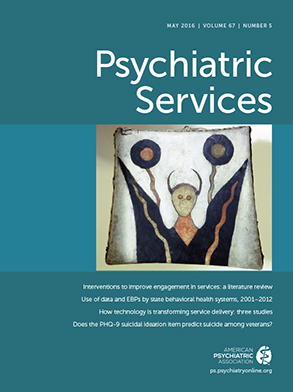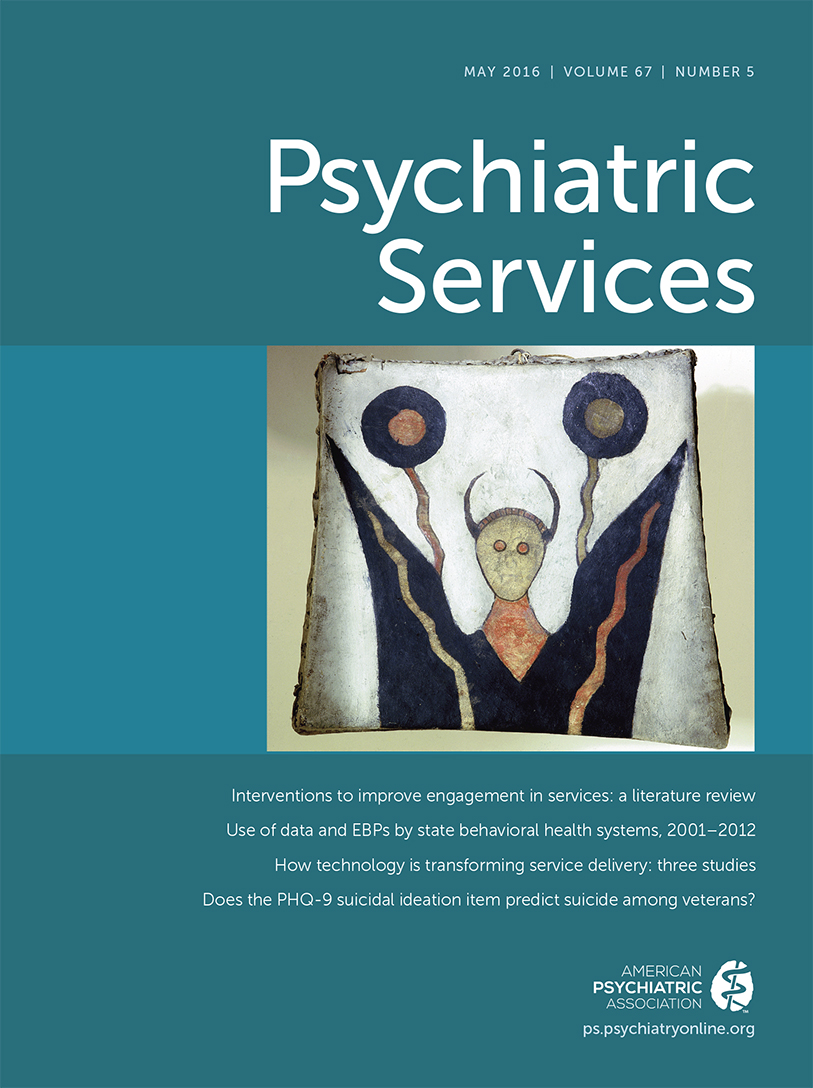The prevalence of psychiatric disorders is significantly higher among jail and prison inmates than among the general population; 40% of Americans with serious mental health problems have been involved with the criminal justice system at some point in their lives (
1,
2). Rates of serious mental health problems during the past year are two to three times higher among probationers and parolees compared with the general population (
3). Treatment for offenders with psychiatric disorders is often unavailable or inconsistent, especially in states with rural populations that are distant from clinical services. One solution to this problem has been to provide such services via telemedicine.
Broadly speaking, telemedicine encompasses all of the health care, education, information, and administrative services that can be transmitted over distances via telecommunication technologies, including Internet-based media and cell phone. (In the context of this study, telepsychiatry specifically refers to the use of videoconferencing with high-bandwidth Internet services.) The use of telepsychiatry has been shown to increase access to care (
4,
5), and it can be an effective means for diagnosing psychiatric disorders, including disorders among adults and elderly persons being treated in emergency rooms and domiciliary care facilities (
6,
7). But the appropriateness of this approach for parolees has yet to be established (
8).
A recent literature review indicates that although telepsychiatry is effective for assessing psychiatric disorders among certain populations, questions remain about the effectiveness of such treatment with underserved communities because of a paucity of randomized clinical trials (
8). Similarly, after conducting a comprehensive review of all telepsychiatry studies published between 1970 and 2000, Monnier and colleagues (
7) concluded, “Although these studies appear promising, they are often limited by their lack of methodologically sound approaches. Overall, research is still lacking in this field that includes reliable baseline data gathered before the implementation of programs, evaluation of clinical outcomes, randomized experimental designs with appropriate control groups, cost analyses, and determination of the effectiveness and efficacy of telepsychiatry for specific patient populations.”
Experts in forensic treatment have called for randomized controlled trials that evaluate the effectiveness of telepsychiatry among offenders under community supervision, but our review of the literature revealed that little progress has been made in reaching that goal (
8). Consequently, we sought to contribute to this literature by conducting a randomized comparison of clinical outcomes among parolees receiving telepsychiatry or in-person care.
Methods
Participants were parolees (N=104) residing in the state of California who were referred to outpatient psychiatric care for the duration of their parole supervision. Participants were recruited from two parole outpatient clinics, and 92% (N=104) of the 114 individuals who were invited to participate agreed to do so. Nearly three-quarters of the participants were male (N=77, 74%), and their mean±SD age was 38.1±10.3 years. The majority (N=40, 38%) described themselves as Hispanic, 30 (29%) as African American, and 29 (28%) as non-Hispanic white.
All procedures for this study were reviewed and approved by the University of California, Los Angeles, Institutional Review Board. Enrollment for this study took place from January 20, 2012, to April 25, 2013. Participants who consented to be a part of the study were asked if they would be willing to be randomly assigned to telepsychiatry or face-to-face treatment, be part of a records-based evaluation to monitor rearrest and custody data, and to subsequently complete a baseline and six-month follow-up interview. Participants were paid $25 for completing the baseline interview and $25 for completing the follow-up interview.
The baseline interview was conducted in person by staff researchers within seven days of initial consent. The follow-up interview, which was conducted six months later over the phone, included assessments of the participants’ satisfaction with telemedicine, therapeutic alliance, medication adherence, and psychological functioning. Seventy-one participants completed the baseline questionnaire and, of those, 60 participants (N=20, telepsychiatry; N=40, control condition) (85%) completed the six-month follow-up assessment.
Randomization was based on whether the parolees’ identification (ID) number ended in an even or odd digit. Those with even-numbered IDs were assigned to the telepsychiatry condition, and those with odd-numbered IDs received the standard face-to-face sessions provided by the parole outpatient clinics. A social worker was present during telepsychiatry sessions to help participants answer questions and set up the telemedicine equipment. Parolees were not permitted to be alone with the videoconferencing equipment.
All of the clinical measures used in this study (with the exception of the Telemedicine Satisfaction Questionnaire [TSQ]) were administered at baseline and again at the time of the six-month follow-up interview.
Psychological functioning was measured with the five-item Brief Symptom Rating Scale (BSRS-5), a self-administered questionnaire containing a subset of items from the 50-item BSRS (
9,
10). Each of the five items is rated from 0, not at all, to 4, extremely. The optimal cutoff point is generally considered to be a score of 5, with scores ≤5 indicating normal functioning. The mean BSRS-5 score for this sample was 8.3±5.3.
The project used a seven-item version of the Working Alliance Inventory (WAI) by Horvath and Greenberg (
11). Neale and Rosenheck (
12) used the WAI to examine outcomes of patients in an intensive treatment program for veterans with serious psychiatric disorders and found it to be predictive of treatment response.
Self-reported medication adherence was measured with the eight-item Morisky Medication Adherence Scale (MMAS), which was developed from a previously validated four-item scale and supplemented with additional items to better capture barriers to adherence behavior (
13). The new scale has been determined to have higher reliability compared with the four-item scale (α=.83 versus .61). MMAS scores can range from 0 to 8 and have been trichotomized previously into three levels of adherence to facilitate use in clinical practice (high adherence, score of 8; medium adherence, 6–8; and low adherence, <6). Prior research revealed that the new scale is significantly (p<.05) associated with pill counts.
Satisfaction with telepsychiatry was assessed by administering a modified version of the TSQ to all parolees in the telepsychiatry condition (
14). Items are rated on a scale from 1, strongly disagree, to 5, strongly agree, with higher scores indicating greater satisfaction. For this sample, both TSQ subscales—quality of care provided and similarity to face-to-face encounters—had high internal consistency (Cronbach’s α=.80).
Results
We enrolled 104 participants and randomly assigned 40 to the telepsychiatry condition and 64 to the control condition (face-to-face sessions). Analyses of baseline characteristics showed no group differences in terms of gender, age, race-ethnicity, or commitment offense.
Changes in psychological functioning, therapeutic alliance, and adherence to prescribed psychiatric medications by study condition were assessed. Repeated-measures analyses of variance showed no significant effects on BSRS-5 scores by group or group × time interaction. A similar pattern was observed for medication adherence, indicating no differences in this variable by group or group × time. With regard to changes in working alliance, there was a marginally significant effect for time (F=3.8, df=1 and 41, p=.06), although the group × time interaction was not statistically significant. Still, the pairwise contrast of WAI scores at follow-up was statistically significant (t=2.1, df=1 and 42, p<.05).
Levels of satisfaction were generally high on both subscales of the TSQ (3.7±1.3 for quality of care provided and 4.0±1.3 for similarity to face-to-face encounters). For both scales, average ratings well exceeded the midpoint of 3, indicating that patients had neutral to favorable perceptions of telepsychiatry compared with in-person psychiatric visits.
Discussion and Conclusions
Consistent with studies of telepsychiatry with populations that were not involved with the corrections system, our study showed comparable effects regarding psychological functioning and medication adherence for telepsychiatry and a control condition over a six-month follow-up period. However, the data also revealed a decline in perceived therapeutic alliance among patients assigned to the telepsychiatry condition.
The disparity in therapeutic alliance was unexpected. Patient preference may have been a contributing factor related to this finding. Although all participants in the study agreed to random assignment, many participants may have preferred one condition over the other. Unfortunately, we did not assess patient preference as part of this study. Another possible factor might be the role of the social worker who accompanied the patient during the session—the presence of this clinician may have affected the patient’s ability to engage with the psychiatrist. Future research with this population would benefit by measuring both of these factors directly.
Although this study had several methodological strengths, including random assignment and a high follow-up rate, it also had several important limitations. First, the sample size—104 parolees who were randomly assigned to telepsychiatry or the control condition, including 71 who participated in the interview portion of the study—undermined our ability to detect any small- or moderate-sized effects. As a result, this study was more aptly powered as a superiority—rather than an equivalence—design, although the latter would be more appropriate in light of the findings from previous studies. Moreover, recruitment of potential telemedicine participants was affected by temporary technical difficulties with telepsychiatry equipment and layoffs of clinic personnel in charge of telemedicine devices at study sites. These barriers help explain the difference in the size of the telepsychiatry (N=40) and control (N=64) groups.
Next, all of the clinical outcomes in this study were based on self-reports over a relatively brief (six-month) period. This limitation could be addressed in future research by including measures such as recidivism and reincarceration and tracking these outcomes over a longer time frame. Although we collected rearrest records in this study, only seven participants had been rearrested during the short time frame, making between-group comparisons impossible. Furthermore, satisfaction data were collected only from telemedicine participants, given that most of the TSQ items were particular to the use of videoconferencing. Last, the sample consisted of patients with varied diagnoses who used a variety of medications and psychotherapies, adding more error variance to an already small study sample.
Notwithstanding these important limitations, we believe that this study represents a modest but legitimate contribution to this literature—especially considering that experimental designs accounted for only about 2% of the published evaluations included in a literature review by Garcia-Lizana and Muñoz-Mayorga (
15) concerning the clinical efficacy of telepsychiatry. This percentage reflects the subset of papers that were peer reviewed and also met other quality standards consistent with Cochrane guidelines. The addition of this study to the published literature provides a small, but relatively rigorous, data point for subsequent meta-analyses and structured reviews aimed at establishing the impact of this rapidly growing approach for providing psychiatric treatment to offenders under community supervision.
Acknowledgments
The authors thank Diana Zaragoza, M.S., and Justine Medrano, M.S., for their help with study coordination, data collection, and data entry. They also thank Kris Langabeer for editorial expertise. They are grateful to the California Department of Corrections and Rehabilitation for their support and assistance on this project. Finally, they thank the participants who agreed to the interview and who shared their life experiences.

